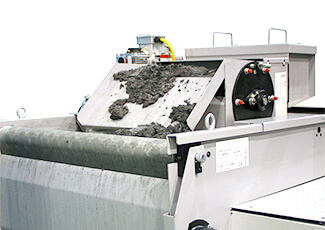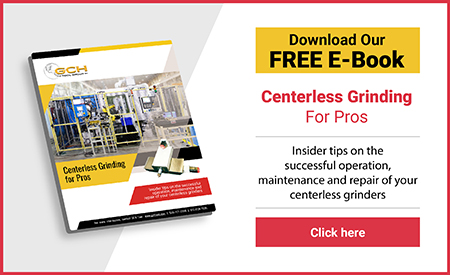Demystifying Centerless Grinders

Centerless grinders are the unsung heroes of the machining world, providing key advantages in roundness, diameter and surface finish that aren’t achievable with lathes and mills.
Despite the critical role it plays in metalworking, centerless grinding is often only faintly understood. Common misperceptions abound that can have a material impact on your part quality and overall productivity.
To demystify the process, here are seven basic principles related to centerless grinders.
1. Deceptive simplicity combined with peerless precision.
Centerless grinding works thanks to a few basic principles of physics.
A grinding wheel and a regulating wheel hold the workpiece in place on a stationary work rest throughout the grinding process. The workpiece is held in place by the pressure of the rotating grinding wheel and the smaller-diameter regulating wheel, with the centerline of the workpiece sitting higher than that centerlines of the two wheels.
“Setting the right height of the work rest is critical to ensuring the correct placement of the workpiece to achieve the necessary roundness and diameter tolerances,” said Dan Geddes, president of GCH Tool Group.
Once grinding begins, the difference in the two wheels’ rotating speeds determines the speed of the removal rate.
“The greater the difference, the faster the removal,” Geddes said. “Furthermore, since no fixturing is needed, centerless grinders require a simplified setup and allow quicker turnaround times.”
Their fast load time, in turn, means centerless grinders operate virtually continuously compared to other forms of machining, he said.
Despite this simplicity, centerless grinders are well-suited for finishing the outside diameter of small cylindrical metal parts requiring tight tolerances. Because they can grind consistently at high speeds, these grinders also are ideal for high-volume applications that require high levels of precision.
“Examples include applications in the medical, aerospace, military and automotive industries,” Geddes said.
2. Where machining ends, centerless grinding begins.
Centerless grinders address the limitations of machining related to dimensions, materials and surface finishes. Basically, centerless grinding takes up where machining leaves off.
“Centerless grinders save the day when it comes to parts that are out of round from a turning machine,” Geddes said. If the part diameter is too small for turning or its center can’t be mounted, centerless grinding can achieve the necessary roundness.
Furthermore, because centerless grinders create no axial thrust on the workpiece, they’re well-suited to grind long pieces of brittle materials that would distort on a lathe or mill.
3. Choosy grinders choose the right wheel.
It’s critical to select the grinding wheel that works well for both the material being ground and the type of finish desired. Wheels are available with different:
- Diameters
- Thicknesses
- Grit sizes
- Grains
“Grit size has a direct impact on the surface finish,” Geddes said. “The smaller the grit, the finer the finish will be.”
Grain types include superabrasives like cubic boron nitride (CBN) or polycrystalline diamond, which provide important benefits like prolonged sharpness, high thermal conductivity and superior durability.
4. Getting the right angle.
Angles and roundness don’t sound like they’d go together, but the proper roundness and tolerance of a workpiece depends on the angles at which the wheels contact the part.
Uneven wear, tapering and reduced wheel life can result if the angle of the regulating wheel is too acute. If the regulating wheel is nearly parallel with the grinding wheel, parts can stall between the wheels or crash.
The angle of the workpiece rest blade also needs to be just right to ensure proper grinding. The width of the grinding wheel is a deciding factor in what that angle should be, with larger wheels generally requiring smaller angles.
5. Cool it for the best results.
Centerless grinding creates a lot of heat, and coolant is needed to remove heat from critical components of a centerless grinder.
Pressurized coolant keeps the grinding wheel at the appropriate temperature, so it won’t crack or blister. The coolant also prevents heat from returning to the workpiece, an important factor since high temperatures can make it difficult to hold roundness and straightness tolerances.
For 24/7 operations, a chiller might be needed to remove heat from the coolant and other fluids, Geddes said. “A coolant filtration system is also useful as it removes swarf and keeps the coolant free of grinding medium particles.”
6. Different feeding methods for different jobs.
There’s one main difference between the two most common forms of centerless grinding: the way in which the workpieces are fed through the grinders.
For parts like gear shafts that have complex shapes, in-feed grinding is the usual choice. In this method, the grinding and regulating wheels need to be dressed to match the part profile, and the work rest must be tooled to match, as well.
For parts with consistent roundness, through-feed grinding is normally used. Driven by a slight angle applied to the regulating wheel relative to the grinding wheel, the workpiece moves along the work rest between the two wheels.
7. Adaptability is the key.
Some centerless grinders have been around for decades. But that doesn’t mean they’re headed for the scrap heap. Centerless grinders are well-suited for upgrades and retrofits, like automation and loaders, electronic machine controls or a servo-drive transmission.
“New technologies allow older centerless grinders to adapt to today’s production demands,” Geddes said. “Upgrades allow these machines to perform better than new.”
Other options include:
Bonus Tip: Experience matters.
While the basic concept of centerless grinding is simple, there are a variety of critical actions – for instance, properly setting the angles of the wheels and work rest or selecting the right grinding wheel – that have a material impact on the final product.
It’s important to find a partner that not only has extensive experience with centerless grinders but also has a clear understanding of your production needs.
GCH Tool has the necessary expertise to provide the components and parts you need for your grinding machine. Contact us today to learn more.

